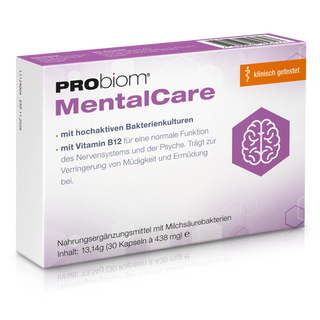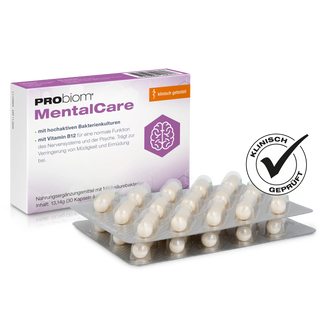At a time when gut health is increasingly seen as key to our overall well-being, probiotics are no longer just a trend. They promise to improve digestion, strengthen the immune system, and even influence mental health. But amidst the numerous products on the market and the many advertising claims, one key question remains: Which probiotics really deliver on their promises?
This article explores this question in depth. We'll show you why not every probiotic delivers its promised benefits. It becomes clear: Probiotics can only be effective if they meet certain quality criteria. We'll explain what these are and how you can recognize them.
What are probiotics?
Probiotics are live microorganisms, primarily lactic acid bacteria or yeasts, which—when ingested in sufficient quantities—provide health benefits to the host. Their primary goal is to support and stabilize the natural intestinal flora, also known as the microbiome.
Our gut is home to approximately 100 trillion bacteria that influence not only our digestion, but also our immune system, hormone balance, and even our psyche. A balanced intestinal flora is therefore crucial for our overall well-being.
Why do some probiotics work and others don’t?
Not all probiotics have the same effect. Many products fail because they either contain insufficient viable bacteria, use the wrong bacterial strains, or are not stored or dosed correctly. For probiotics to be fully effective, they must meet a number of quality criteria .
The most important quality criteria for effective probiotics
Specificity of bacterial strains
Not all bacteria are created equal. It's not just the genus (e.g., Lactobacillus or Bifidobacterium ) that matters, but also the specific strain. Only when this strain has been scientifically studied and clearly identified can statements about its effectiveness be made. For example, the strain Lactobacillus rhamnosus GG is well documented and has proven effectiveness in treating diarrhea.
Sufficient bacterial count
A probiotic must contain enough viable bacteria to reach the intestines. As a rule of thumb, at least 1 billion colony-forming units (CFU) per dose are needed—even more for certain diseases.
Gastric acid resistance
For the bacteria to be effective, they must pass through the stomach without being killed. Only bacteria that are highly resistant to stomach acid or are encapsulated in special, enteric-coated capsules can become active in the intestine.
Clinical trials
Reliable probiotics have been tested for their effectiveness in randomized, placebo-controlled trials . The manufacturer should provide transparent information about these studies, including the bacterial strains used.
Stability and durability
A good probiotic remains stable until its expiration date. Many products lose their effectiveness over time, especially if stored improperly.
No unnecessary additives
Avoid products that contain unnecessary sweeteners, colorings, or preservatives . These not only harm bacteria but can also have negative effects on gut health.
How do I recognize high-quality probiotics on the market?
Many manufacturers advertise with high numbers, such as "10 billion live cultures!" or "with 12 different strains!" But quantity does not equal quality. Keep the following points in mind:
-
Exact name of the bacterial strains : The full name including genus, species and strain number (e.g. Lactobacillus plantarum 299v).
-
Bacterial count per dose : This should be guaranteed at the time of consumption, not just during production.
-
Storage information : Proper storage (e.g. “keep cool”) is important for shelf life and effectiveness.
-
Studies and evidence : Trust products that are supported by clinical studies.
When and why do probiotics work?
The effect of probiotics depends not only on the product itself, but also on the application situation:
-
After antibiotic therapy : Antibiotics kill not only harmful but also beneficial intestinal bacteria. Probiotics such as Lactobacillus rhamnosus GG or Saccharomyces boulardii can help restore the balance of intestinal flora and prevent antibiotic-associated diarrhea.
-
For acute intestinal diseases : Certain strains have proven effective in treating traveler's diarrhea ( Saccharomyces boulardii ), irritable bowel syndrome ( Lactobacillus plantarum 299v), or chronic inflammatory bowel disease ( Bifidobacterium infantis 35624). These can noticeably relieve symptoms such as diarrhea, flatulence, or inflammation.
-
For prevention : Probiotics can also be used preventively – for example to reduce allergic symptoms such as hay fever ( Lactobacillus paracasei LP-33 & GMNL-133), to strengthen the immune system ( Bifidobacterium lactis BB-12), to provide mental support in cases of stress or sleep problems ( Lactobacillus helveticus Rosell®-52 & Bifidobacterium longum Rosell®-175), and to improve oral health ( Streptococcus salivarius M18).
Overview: Specific probiotic strains by health area
| Health sector | Root name | Area of application | Instructions for use |
|---|---|---|---|
| Allergies | Lactobacillus paracasei LP-33 & GMNL-133 | Allergic rhinitis, hay fever, immunomodulation | Take at least 1 month before the start of the pollen season and continue daily for several weeks |
| Oral health | Streptococcus salivarius M18 | Caries prevention, bad breath, gum health | In the form of lozenges, in the evening after brushing your teeth |
| Mental health | Lactobacillus helveticus Rosell®-52 & Bifidobacterium longum Rosell®-175 | Stress reduction, sleep quality, emotional balance | Combination ideal, daily intake for at least 4 weeks recommended |
| intestinal health | Lactobacillus rhamnosus GG | Diarrhea, antibiotic-associated diarrhea | Effective support after antibiotic therapy, in case of diarrhea or skin problems |
| Saccharomyces boulardii | Traveler's diarrhea, clostridial infections, antibiotic use | Especially helpful for diarrhea caused by antibiotics or travel | |
| Bifidobacterium lactis BB-12 | immune system, digestive support | Promotes the general immune system and helps with digestive problems | |
| Lactobacillus plantarum 299v | Irritable bowel syndrome | Helps with symptoms of irritable bowel syndrome, especially bloating and pain | |
| Bifidobacterium infantis 35624 | Chronic inflammatory bowel diseases | Supports therapy in inflammatory bowel diseases such as Crohn's disease |
Common mistakes when using probiotics
Incorrect storage : Many bacteria are sensitive to heat and light. Therefore, always store probiotics according to the manufacturer's instructions—usually in the refrigerator.
Impatience : Probiotics take time. The first effects often appear after 1–2 weeks, and a stable effect only occurs after several weeks of continuous use.
Taking without medical advice : Especially in cases of chronic diseases or immune deficiency, the use of probiotics should be coordinated with a doctor or nutritionist.
Non-specific products : Products without specific strains or those that do not have study evidence usually do not provide reliable results.
Conclusion: Which probiotics really work?
Probiotics can only be effective if they meet certain quality standards. These include:
-
Scientifically studied strains
-
Sufficient bacterial count
-
Gastric acid resistance
-
Stability and durability
-
Scientific evidence
Probiotics that don't meet these criteria can be ineffective at best—and even harmful at worst. To truly reap the benefits of probiotics, choose high-quality products that offer clearly labeled strains and clinical evidence.


















